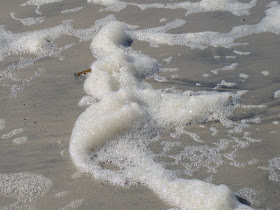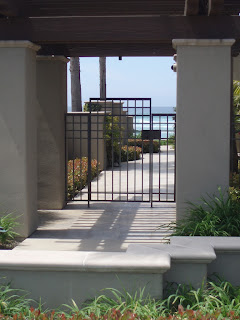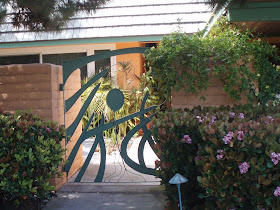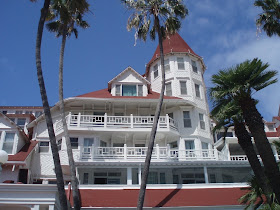



 Along the wide walk beside the beach, we waited to see the runners. Around 8:45 AM they were around half way from the starting point of the half-marathon, in Del Mar, and had run up the incredible hill at Torrey Pines park. The leaders were very spread out, coming one at a time down the long walk near the sea. Casual runners, cyclists, dog walkers, children, and surfers shared the space, doing what they always do on a beautiful Sunday morning.
Along the wide walk beside the beach, we waited to see the runners. Around 8:45 AM they were around half way from the starting point of the half-marathon, in Del Mar, and had run up the incredible hill at Torrey Pines park. The leaders were very spread out, coming one at a time down the long walk near the sea. Casual runners, cyclists, dog walkers, children, and surfers shared the space, doing what they always do on a beautiful Sunday morning.
 Race officials came along in cars, on bikes and on foot. Also we saw policemen on motorcycles, volunteer water-servers at tables of full paper cups, and other helpers.
Race officials came along in cars, on bikes and on foot. Also we saw policemen on motorcycles, volunteer water-servers at tables of full paper cups, and other helpers. A surfer in a dripping wetsuit ran up and started handing out cups of water to the runners. Most of the helpers called out "water, water," but one said "Budweiser."
A surfer in a dripping wetsuit ran up and started handing out cups of water to the runners. Most of the helpers called out "water, water," but one said "Budweiser." The conditions must have been good this morning, as more than the usual number of surfers waiting in the water were managing to stand up on a wave. Normally a race occupies everyone's full attention. Not this one. Lots of people along the way were just enjoying the sun and scenery, with not a look at the competitors.
The conditions must have been good this morning, as more than the usual number of surfers waiting in the water were managing to stand up on a wave. Normally a race occupies everyone's full attention. Not this one. Lots of people along the way were just enjoying the sun and scenery, with not a look at the competitors.




 Bataquitos Lagoon was blocked in the 1880s when the railroad bridge was built. We overlooked the railroad, the beach, and the connecting waterway in a beautiful little overlook point behind a huge housing development on the upland. The connector was re-established in the 1980s, thus making it tidal again. This restored the lagoon to a somewhat original state -- or so it is hoped. On the sandy buildup, a large colony of least terns has established itself, which is a good sign.
Bataquitos Lagoon was blocked in the 1880s when the railroad bridge was built. We overlooked the railroad, the beach, and the connecting waterway in a beautiful little overlook point behind a huge housing development on the upland. The connector was re-established in the 1980s, thus making it tidal again. This restored the lagoon to a somewhat original state -- or so it is hoped. On the sandy buildup, a large colony of least terns has established itself, which is a good sign. To go from one basin of San Elijo Lagoon to the other, we walked on a rather iffy path under the freeway.
To go from one basin of San Elijo Lagoon to the other, we walked on a rather iffy path under the freeway.




 I'm not sure I need to read more about the theft of Mona Lisa in 1911. Can any more be said than has been, in historical fiction and in tomes like this? The review:
I'm not sure I need to read more about the theft of Mona Lisa in 1911. Can any more be said than has been, in historical fiction and in tomes like this? The review:Part love story, part mystery, Vanished Smile reopens the case of the most audacious and perplexing art theft ever committed. R. A. Scotti’s riveting, ingeniously realized account is itself a masterly portrait of a world in transition. Combining her skills as a historian and a novelist, Scotti turns the tantalizing clues into a story of the painting’s transformation into the most familiar and lasting icon of all time.


 The end of the road in fairy tales is usually a mysterious place, where perhaps you come up to a cliff or a forest too dense or too threatening to enter. In Torrey Pines park, the end is at a big chain-link fence protecting the golf course.
The end of the road in fairy tales is usually a mysterious place, where perhaps you come up to a cliff or a forest too dense or too threatening to enter. In Torrey Pines park, the end is at a big chain-link fence protecting the golf course.












 Yesterday I discovered the connection between the Emerald City of Oz and Coronado, California. L.Frank Baum, once he had made some major money on The Wizard of Oz, began to spend long vacations at the luxurious Hotel del Coronado. The Crown Room, as illustrated here, retains its original chandeliers and amazing tongue-in-groove paneled ceilings. We managed to get ourselves in by approaching a security guard and asking if we could see it!
Yesterday I discovered the connection between the Emerald City of Oz and Coronado, California. L.Frank Baum, once he had made some major money on The Wizard of Oz, began to spend long vacations at the luxurious Hotel del Coronado. The Crown Room, as illustrated here, retains its original chandeliers and amazing tongue-in-groove paneled ceilings. We managed to get ourselves in by approaching a security guard and asking if we could see it! The Coronado was the first building in the San Diego area to use electric lighting -- as attested by the 1880s era power plant seen out the window of the Crown Room, and the crown lighting fixtures. Obviously, there's a Crown Room influence in the Emerald City, too.
The Coronado was the first building in the San Diego area to use electric lighting -- as attested by the 1880s era power plant seen out the window of the Crown Room, and the crown lighting fixtures. Obviously, there's a Crown Room influence in the Emerald City, too. The Lobby is in the old and wonderful Grand Hotel style, and also retains the original panelling and chandeliers. Somehow when many others were torn down, the Del was only neglected -- which means it was preserved. Its most famous moment in the run-down and seedy part of its history was its use as a cheap set for the film "Some Like it Hot."
The Lobby is in the old and wonderful Grand Hotel style, and also retains the original panelling and chandeliers. Somehow when many others were torn down, the Del was only neglected -- which means it was preserved. Its most famous moment in the run-down and seedy part of its history was its use as a cheap set for the film "Some Like it Hot."




 We enjoyed the visit to Coronado with Ellen and Alec. After our walk around the Hotel, we ate lunch at Rhinoceros. We visited the small museum which has an excellent pictorial and video presentation on L.Frank Baum, including a 10 minute excerpt from one of his World War I era Oz films -- all unsuccessful: he lost a lot of money in Hollywood.
We enjoyed the visit to Coronado with Ellen and Alec. After our walk around the Hotel, we ate lunch at Rhinoceros. We visited the small museum which has an excellent pictorial and video presentation on L.Frank Baum, including a 10 minute excerpt from one of his World War I era Oz films -- all unsuccessful: he lost a lot of money in Hollywood.
If I regret anything, it is my good behavior.
What demon possessed me that I behaved so well?
 Louis Bayard's historical novel The Pale Blue Eye is a great read! I really loved it. The action takes place at West Point in 1830, and Edgar Allan Poe -- who was in actuality a student there -- is a major character. The mysterious deaths at the center of the plot, as well as the retired police detective charged with solving them, are the creation of the highly imaginative and scholarly author. I won't say more because I don't want to put in any spoilers.
Louis Bayard's historical novel The Pale Blue Eye is a great read! I really loved it. The action takes place at West Point in 1830, and Edgar Allan Poe -- who was in actuality a student there -- is a major character. The mysterious deaths at the center of the plot, as well as the retired police detective charged with solving them, are the creation of the highly imaginative and scholarly author. I won't say more because I don't want to put in any spoilers. The San Diego Zoo and Wild Animal Park are two wonderful places. The Wild Animal Park has large open spaces where some of the largest animals live and breed very happily -- rhinos, elephants, giraffes, gorillas. The zoo is smaller scale in some ways. But the huge polar bears are at the zoo. And the tiny butterflies in the special WAP exhibit can land on your hat or shirt so delicately that you don't feel a thing.
The San Diego Zoo and Wild Animal Park are two wonderful places. The Wild Animal Park has large open spaces where some of the largest animals live and breed very happily -- rhinos, elephants, giraffes, gorillas. The zoo is smaller scale in some ways. But the huge polar bears are at the zoo. And the tiny butterflies in the special WAP exhibit can land on your hat or shirt so delicately that you don't feel a thing.




